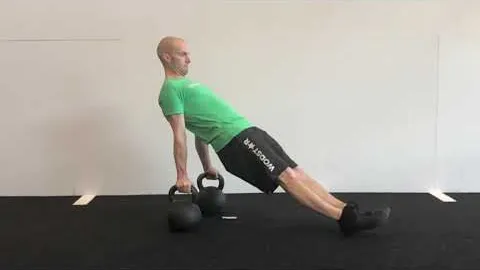
The kettlebell dip to extension is a highly effective exercise that targets multiple muscle groups and promotes full-body strength and stability. This compound movement engages your triceps, shoulders, core muscles, and upper back, helping to improve overall upper body strength and muscular endurance. In this article, we will guide you through the proper form and technique of the kettlebell dip to extension, along with its benefits and variations.
Full-body workout: The kettlebell dip to extension targets various muscle groups simultaneously, providing a comprehensive workout for your upper body. This exercise engages the triceps, shoulders, chest, core, and upper back muscles, helping to build strength and stability.
Improves upper body strength: By incorporating the dip and extension movements, this exercise specifically targets the triceps, shoulders, and chest muscles, helping you develop significant upper body strength. Strengthening these muscles can benefit daily activities that involve pushing or lifting heavy objects.
Enhances core stability: The kettlebell dip to extension requires holding your body in a strong and stable position throughout the movement. This engages the core muscles, including the rectus abdominis, obliques, and lower back muscles, helping to improve overall core strength and stability.
Boosts muscular endurance: Performing kettlebell dip to extension exercises with proper form and technique can help increase your muscular endurance. This can be particularly beneficial for athletes, as well as individuals looking to improve their overall physical fitness.
Increases shoulder stability: The kettlebell dip to extension recruits the shoulder muscles, including the deltoids, rotator cuff muscles, and scapular stabilizers. Regularly performing this exercise can help strengthen the muscles around the shoulder joint, promoting stability and reducing the risk of injuries.
Follow these steps to properly perform the kettlebell dip to extension exercise:
Starting Position: Begin by sitting on the edge of a stable bench or chair, gripping a kettlebell with both hands, palms facing down. Position yourself close to the edge of the bench, bending your knees and touching your feet to the ground.
Dip Motion: Lower your body by bending your elbows, keeping them close to your sides. Lower yourself until your upper arms are parallel to the ground or slightly below. Your chest should remain lifted, and your shoulders should be down and back, engaging the chest and core muscles.
Extension Motion: Push through your palms and straighten your arms, extending your body back up to the starting position. Avoid locking your elbows at the top of the movement to maintain continuous tension on the muscles.
Controlled Tempo: Maintain a controlled tempo throughout the exercise, ensuring that you're engaging the targeted muscles and avoiding any jerky or sudden movements. Focus on form and technique rather than speed or reps.
Breathing: Remember to breathe throughout the exercise. Inhale during the downward phase (dip), and exhale during the upward phase (extension).
To maximize the benefits and minimize the risk of injury, keep the following tips in mind:
Start with an appropriate weight: Select a kettlebell that allows you to perform the exercise with proper form and technique while still challenging your muscles. It's better to start with a lighter weight and gradually increase as you become more comfortable with the movement.
Maintain proper posture: Focus on maintaining a neutral spine alignment throughout the exercise. Avoid slouching or arching your back, as this can put unnecessary strain on your lower back.
Engage your core: Throughout the exercise, engage your core muscles by drawing your belly button in towards your spine. This will help stabilize your body and protect your lower back.
Avoid shoulder shrugging: Ensure that your shoulders remain down and relaxed throughout the movement. Shrug-free movements help engage the intended muscles effectively.
Once you've mastered the basic dip to extension, you can explore different variations to further challenge yourself and target specific muscle groups. Here are a few variations you can try:
Single-arm kettlebell dip to extension: Perform the exercise with only one kettlebell, alternating between arms to target each side of your body separately. This variation adds an element of stability and balance.
Weighted kettlebell dip to extension: Increase the intensity of the exercise by using a heavier kettlebell, challenging your muscles further and promoting strength gains.
Diamond push-up kettlebell dip to extension: Instead of placing your hands on a bench, perform the dip by assuming a diamond push-up position with your hands on the kettlebell handles. This variation increases the demand on your triceps.
The kettlebell dip to extension exercise is an excellent addition to any strength training routine. Incorporating this compound movement into your workouts can lead to improved upper body strength, enhanced core stability, and increased shoulder strength and stability. By following the proper form and gradually progressing, you can reap the benefits of this versatile exercise. Remember to consult with a fitness professional before starting any new exercise program, especially if you have pre-existing conditions or injuries. Start with light weights, focus on proper technique, and gradually increase the intensity as you build strength and confidence.
If you're looking for a gym, fitness club or yoga studio, you've come to the right place.
You can find information about gyms in your area. Browse catalog of gyms and find gyms with classes which are you looking for.
On gym page you can find simple information like address, phone or website. You can find list of available classes. You can check availability of personal training or small group classes. On place page you can also see information about open hours.
You can find gyms near you with amenities, courts, studios and equipments.
Use our map to find gym at your city or district.
In Gym Navigator you can find list of exercises with movies for many body parts.
You can browse exercises catalog and find exercises the best of you.
You can also find exercises grouped into workout plans, which you can use to improve you body. Each routine show you exercises one by one and give you possibility to count you progress and count down rest time.